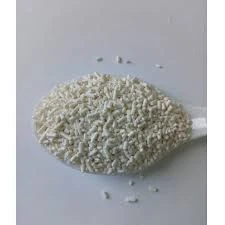
monosodium glutamate process
The Process of Producing Monosodium Glutamate An Overview
Monosodium glutamate (MSG) is a flavor enhancer commonly used in the culinary world, widely recognized for its ability to elevate the savory taste of foods. While MSG has been a subject of debate regarding its health effects, its production process is a fascinating mix of science and technology. This article aims to elucidate the steps involved in the production of MSG, highlighting the key components and methods utilized in this intricate manufacturing process.
1. Raw Material Selection
The journey of MSG production begins with the careful selection of raw materials. The primary ingredient for MSG is glutamic acid, an amino acid that occurs naturally in various foods such as tomatoes, cheese, and mushrooms. Although glutamic acid can be extracted from these natural sources, it is far more economical and efficient to produce it through fermentation. The primary sources used in the fermentation process are carbohydrates, often derived from starch sources like corn, sugar cane, or tapioca.
2. Fermentation Process
The fermentation process is the heart of MSG production. In this stage, specific strains of bacteria, such as *Corynebacterium glutamicum*, are employed to convert sugars into glutamic acid. The fermentation is carried out in large bioreactors where conditions such as temperature, pH, and oxygen levels are carefully controlled to maximize bacterial growth and glutamic acid production.
The basic procedure involves
- Inoculation The selected bacterial strains are inoculated into a nutrient-rich medium containing sugars and other minerals. - Fermentation The bioreactor is maintained under optimal conditions for several hours to days, depending on the bacterial strain and desired yield. During this time, the bacteria metabolize the sugars and produce glutamic acid as a byproduct.
3. Isolation and Purification
Once the fermentation process is complete, the next step is to isolate the glutamic acid from the fermentation broth. This is typically done through a series of filtration and centrifugation processes, which help separate the bacterial cells and any residual materials from the desired amino acid.
monosodium glutamate process

The glutamic acid is then purified using crystallization techniques
. By adjusting factors such as temperature and concentration, producers can obtain high-purity glutamic acid crystals.4. Sodium Addition
The next critical step is the neutralization of glutamic acid to produce monosodium glutamate. This is achieved by adding sodium hydroxide or sodium carbonate to the purified glutamic acid. The reaction neutralizes the amino acid, resulting in the formation of monosodium glutamate. The chemical reaction can be summarized as follows
\[ \text{Glutamic acid (C5H9NO4)} + \text{Sodium hydroxide (NaOH)} \rightarrow \text{Monosodium glutamate (C5H8NNaO4)} + \text{Water (H2O)} \]
5. Crystallization
After the formation of monosodium glutamate, the next step is to crystallize the compound. The resulting solution is concentrated and cooled to allow MSG to crystallize. The crystals are collected through centrifugation, washed, and dried to remove any residual moisture.
6. Quality Control
Quality control is vital at every stage of the MSG production process. Finished products are subjected to rigorous tests to ensure they meet safety and quality standards. This includes tests for purity, flavor profile, and the absence of contaminants. Regulatory bodies often oversee the production process to ensure compliance with food safety standards.
Conclusion
The production of monosodium glutamate is a sophisticated process that combines biological, chemical, and engineering principles. From fermentation to crystallization, each step is designed to optimize yield and purity, making MSG a commercially valuable ingredient in food production. As the culinary world continues to evolve, understanding the processes behind flavor enhancers like MSG can enrich our appreciation of the science involved in food preparation and preservation. Whether enjoyed in a favorite dish or used as a cooking staple, MSG’s journey from raw materials to the kitchen is a testament to human ingenuity and the quest for enhanced flavors.
-
The Safety Challenges of Ammonium Nitrate FertilizerNewsJun.26,2025
-
The Critical Role of Mining ChemicalsNewsJun.26,2025
-
Shelf Life of Glacial Acetic Acid Food GradeNewsJun.26,2025
-
Enhancing PVC Longevity with 1,2,3-Benzotriazole InnovationsNewsJun.26,2025
-
China’s Dominance in Food Additive ProductionNewsJun.26,2025
-
Can Aluminum Hydroxide Replace More Toxic Alternatives?NewsJun.26,2025
-
PE and PP Plastics with Benzotriazole AdditivesNewsJun.12,2025
Hebei Tenger Chemical Technology Co., Ltd. focuses on the chemical industry and is committed to the export service of chemical raw materials.
-

view more DiethanolisopropanolamineIn the ever-growing field of chemical solutions, diethanolisopropanolamine (DEIPA) stands out as a versatile and important compound. Due to its unique chemical structure and properties, DEIPA is of interest to various industries including construction, personal care, and agriculture. -

view more TriisopropanolamineTriisopropanolamine (TIPA) alkanol amine substance, is a kind of alcohol amine compound with amino and alcohol hydroxyl, and because of its molecules contains both amino and hydroxyl. -

view more Tetramethyl Thiuram DisulfideTetramethyl thiuram disulfide, also known as TMTD, is a white to light-yellow powder with a distinct sulfur-like odor. It is soluble in organic solvents such as benzene, acetone, and ethyl acetate, making it highly versatile for use in different formulations. TMTD is known for its excellent vulcanization acceleration properties, which makes it a key ingredient in the production of rubber products. Additionally, it acts as an effective fungicide and bactericide, making it valuable in agricultural applications. Its high purity and stability ensure consistent performance, making it a preferred choice for manufacturers across various industries.











